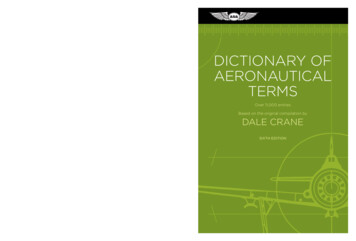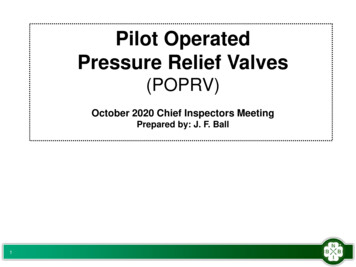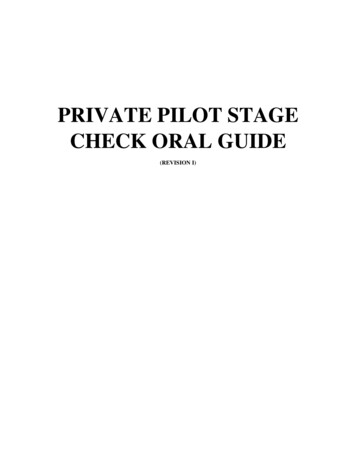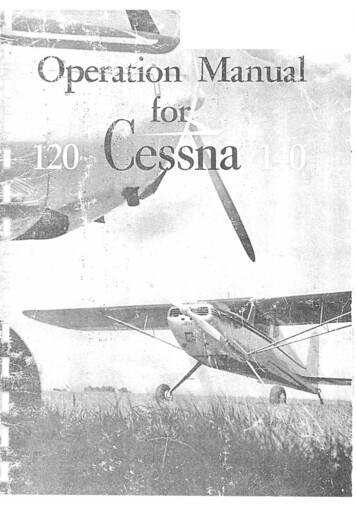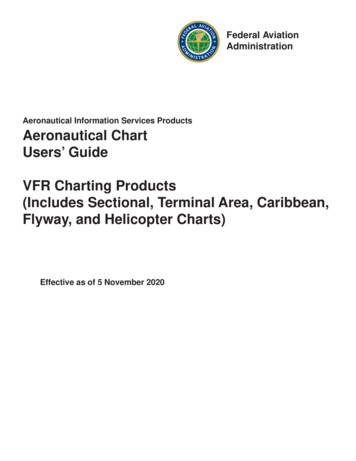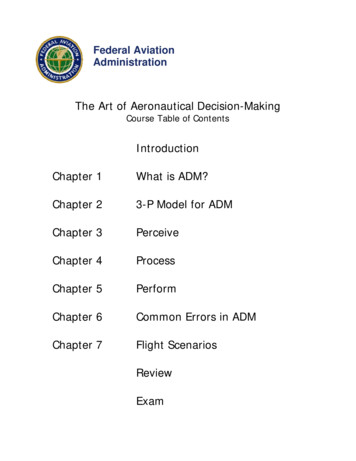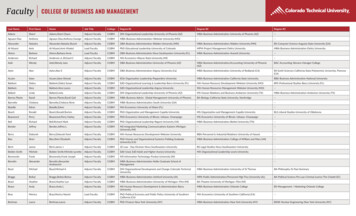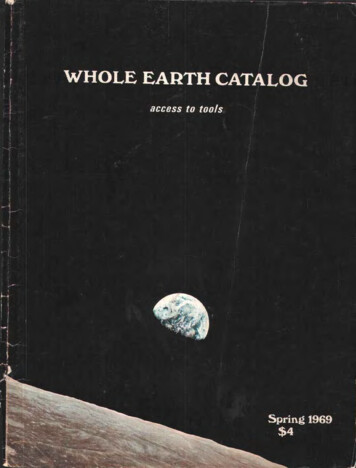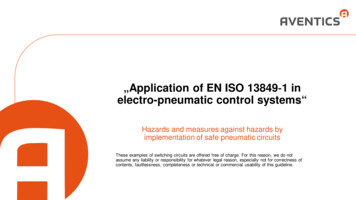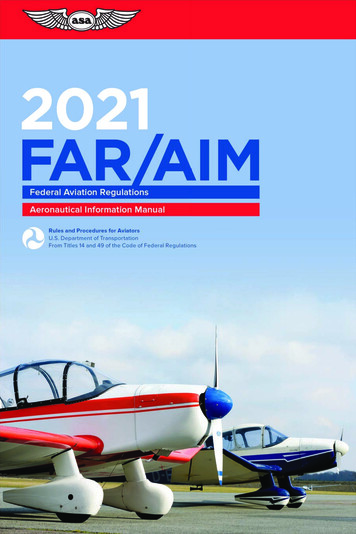
Transcription
Pilot’s Handbook ofAeronautical Knowledge2008U.S. Department of TransportationFEDERAL AVIATION ADMINISTRATIONFlight Standards Service
ii
PrefaceThe Pilot’s Handbook of Aeronautical Knowledge provides basic knowledge that is essential for pilots. This handbookintroduces pilots to the broad spectrum of knowledge that will be needed as they progress in their pilot training. Except forthe Code of Federal Regulations pertinent to civil aviation, most of the knowledge areas applicable to pilot certification arepresented. This handbook is useful to beginning pilots, as well as those pursuing more advanced pilot certificates.Occasionally the word “must” or similar language is used where the desired action is deemed critical. The use of such languageis not intended to add to, interpret, or relieve a duty imposed by Title 14 of the Code of Federal Regulations (14 CFR).It is essential for persons using this handbook to become familiar with and apply the pertinent parts of 14 CFR and theAeronautical Information Manual (AIM). The AIM is available online at www.faa.gov. The current Flight StandardsService airman training and testing material and learning statements for all airman certificates and ratings can be obtainedfrom www.faa.gov.This handbook supersedes FAA-H-8083-25, Pilot’s Handbook of Aeronautical Knowledge, dated 2003.This handbook is available for download, in PDF format, from www.faa.gov.This handbook is published by the United States Department of Transportation, Federal Aviation Administration, AirmanTesting Standards Branch, AFS-630, P.O. Box 25082, Oklahoma City, OK 73125.Comments regarding this publication should be sent, in email form, to the following address:AFS630comments@faa.goviii
iv
AcknowledgmentsThe Pilot’s Handbook of Aeronautical Knowledge was produced by the Federal Aviation Administration (FAA) with theassistance of Safety Research Corporation of America. The FAA wishes to acknowledge the following contributors:Mrs. Nancy A. Wright for providing imagery of a de Haviland DH-4 inaugural air mail flight (Chapter 1)The Raab Collection, Philadelphia, Pennsylvania, for images of the first pilot license (Chapter 1)Sandy Kenyon and Rod Magner (magicair.com) for photo of 1929 TravelAir 4000 (Chapter 1)Adventure Seaplanes for photos of a ski and float training plane (Chapter 2)Jack Davis, Stearman Restorers Asociation, for photo of a 1941 PT-17 Army Air Corps trainer (Chapter 2)Michael J. Hoke, Abaris Training Resources, Inc., for images and information about composite aircraft (Chapter 2)M. van Leeuwen (www.zap16.com) for image of Piaggio P-180 (Chapter 5)Greg Richter, Blue Mountain Avionics, for autopilot information and imagery (Chapter 5)Mountain High E&S Company for various images provided regarding oxygen systems (Chapter 6)Jeff Callahan, Aerox, for image of MSK-AS Silicone Mask without Microphone (Chapter 6)Nonin Medical, Inc. for image of Onyx pulse oximeter (Chapter 6)Pilotfriend.com for photo of a TKS Weeping Wing (Chapter 6)Chelton Flight Systems for image of FlightLogic (Chapter 7)Avidyne Corporation for image of the Entegra (Chapter 7)Teledyne Controls for image of an air data computer (Chapter 7)Watson Industries, Inc. (www.watson-gyro.com) for image of Attitude and Heading Reference system (Chapter 7)Dr. Pat Veillette for information used on decision-making (Chapter 17)John Park for image of spinning plates (Chapter 17)Cessna Aircraft Company, Columbia Aircraft Manufacturing Corporation, Eclipse Aviation Corporation, Garmin Ltd.,The Boeing Company for images provided and used throughout the Handbook.Additional appreciation is extended to the Aircraft Owners and Pilots Association (AOPA), the AOPA Air Safety Foundation,the General Aviation Manufacturers Association (GAMA), and the National Business Aviation Association (NBAA) fortheir technical support and input.v
vi
Table of ContentsPreface .iiiAcknowledgments .vTable of Contents .viiChapter 1Introduction To Flying.1-1Introduction .1-1History of Flight.1-2History of the Federal Aviation Administration (FAA) 1-3Transcontinental Air Mail Route.1-4Federal Certification of Pilots and Mechanics .1-4The Civil Aeronautics Act of 1938 .1-5The Federal Aviation Act of 1958.1-6Department of Transportation (DOT) .1-6Air Traffic Control (ATC) Automation .1-6The Professional Air Traffic ControllersOrganization (PATCO) Strike .1-7The Airline Deregulation Act of 1978 .1-7Role of the Federal Aviation Administration (FAA) .1-7The Code of Federal Regulations (CFR).1-7Primary Locations of the FAA .1-8Field Offices.1-8Aviation Safety Inspector (ASI) .1-9FAA Safety Team (FAASTeam).1-9Obtaining Assistance from the FAA .1-9FAA Reference Material .1-9Aeronautical Information Manual (AIM) .1-9Handbooks .1-10Advisory Circulars (ACs) .1-10Flight Publications .1-11Pilot and Aeronautical Information .1-11Notices to Airmen (NOTAMs) .1-11Safety Program Airmen NotificationSystem (SPANS) .1-12Aircraft Types and Categories .1-12Ultralight Vehicles .1-12Light Sport Aircraft (LSA) Category .1-12Pilot Certifications .1-13Sport Pilot .1-14Recreational Pilot .1-14Private Pilot .1-14Commercial Pilot.1-14Airline Transport Pilot .1-15Selecting a Flight School .1-15How To Find a Reputable Flight Program .1-15How To Choose a Certificated Flight Instructor(CFI) .1-16The Student Pilot .1-16Basic Requirements .1-16Medical Certification Requirements .1-17Becoming a Pilot .1-17Knowledge and Skill Examinations .1-18Knowledge Examination .1-18When To Take the Examination .1-18Where To Take the Examination .1-18Practical Examination .1-18When To Take the Practical Exam .1-19Who Administers the Practical Examination? .1-20Role of the Certificated Flight Instructor .1-20Role of the Designated Pilot Examiner .1-20Chapter Summary .1-21Chapter 2Aircraft Structure .2-1Introduction .2-1Lift and Basic Aerodynamics.2-2Major Components.2-3Fuselage .2-3Wings .2-3Empennage .2-5Landing Gear .2-6The Powerplant .2-6Subcomponents .2-7Types of Aircraft Construction .2-7Truss Structure .2-7Semimonocoque .2-8vii
Composite Construction .2-8History .2-8Composite Materials in Aircraft .2-9Advantages of Composites .2-9Disadvantages of Composites .2-9Fluid Spills on Composites .2-10Lightning Strike Protection.2-10The Future of Composites .2-11Instrumentation: Moving into the Future .2-11Control Instruments .2-12Navigation Instruments .2-12Global Positioning System (GPS).2-12Chapter 3Principles of Flight .3-1Introduction .3-1Structure of the Atmosphere .3-1Atmospheric Pressure .3-2Pressure Altitude .3-2Density Altitude .3-3Effect of Pressure on Density .3-3Effect of Temperature on Density .3-3Effect of Humidity (Moisture) on Density .3-3Theories in the Production of Lift.3-4Newton’s Basic Laws of Motion .3-4Magnus Effect .3-4Flow of Air Against a Nonrotating Cylinder .3-5A Rotating Cylinder in a Motionless Fluid.3-5A Rotating Cylinder in a Moving Fluid .3-5Bernoulli’s Principle of Differential Pressure .3-7Airfoil Design .3-7Low Pressure Above .3-8High Pressure Below .3-9Pressure Distribution .3-9Airfoil Behavior .3-10A Third Dimension .3-10Chapter Summary .3-10Chapter 4Aerodynamics of Flight.4-1Forces Acting on the Aircraft .4-1Thrust .4-2Drag .4-3Parasite Drag .4-4Induced Drag .4-5Lift/Drag Ratio.4-6Weight .4-7Lift .4-7Wingtip Vortices .4-8Formation of Vortices .4-8viiiAvoiding Wake Turbulence .4-8Ground Effect.4-9Axes of an Aircraft.4-11Moment and Moment Arm .4-12Aircraft Design Characteristics .4-12Stability .4-12Static Stability .4-13Dynamic Stability .4-13Longitudinal Stability (Pitching) .4-14Lateral Stability (Rolling) .4-16Vertical Stability (Yawing).4-17Free Directional Oscillations (Dutch Roll) .4-18Spiral Instability .4-18Aerodynamic Forces in Flight Maneuvers.4-19Forces in Turns .4-19Forces in Climbs.4-21Forces in Descents .4-21Stalls .4-22Basic Propeller Principles .4-23Torque and P-Factor .4-26Torque Reaction .4-26Corkscrew Effect .4-26Gyroscopic Action.4-27Asymmetric Loading (P-Factor) .4-27Load Factors.4-28Load Factors in Aircraft Design .4-28Load Factors in Steep Turns.4-29Load Factors and Stalling Speeds .4-30Load Factors and Flight Maneuvers .4-31Vg Diagram .4-32Rate of Turn .4-33Radius of Turn .4-34Weight and Balance .4-35Effect of Weight on Flight Performance .4-37Effect of Weight on Aircraft Structure .4-37Effect of Weight on Stability and Controllability .4-38Effect of Load Distribution .4-38High Speed Flight .4-39Subsonic Versus Supersonic Flow .4-39Speed Ranges .4-40Mach Number Versus Airspeed .4-41Boundary Layer .4-41Laminar Boundary Layer Flow .4-41Turbulent Boundary Layer Flow .4-41Boundary Layer Separation .4-41Shock Waves .4-42Sweepback .4-43Mach Buffet Boundaries .4-44High Speed Flight Controls .4-45Chapter Summary .4-46
Chapter 5Flight Controls .5-1Introduction .5-1Flight Control Systems .5-2Flight Controls.5-2Primary Flight Controls .5-2Elevator .5-5T-Tail .5-6Stabilator .5-6Canard .5-7Rudder.5-7V-Tail .5-8Secondary Flight Controls .5-8Flaps .5-8Leading Edge Devices .5-9Spoilers .5-10Trim Tabs.5-10Balance Tabs .5-11Antiservo Tabs .5-11Ground Adjustable Tabs .5-11Adjustable Stabilizer .5-12Autopilot .5-12Chapter Summary .5-12Chapter 6Aircraft Systems .6-1Introduction .6-1Powerplant .6-1Reciprocating Engines.6-2Propeller .6-4Fixed-Pitch Propeller .6-5Adjustable-Pitch Propeller .6-6Induction Systems .6-7Carburetor Systems .6-7Mixture Control .6-8Carburetor Icing .6-8Carburetor Heat .6-9Carburetor Air Temperature Gauge .6-10Outside Air Temperature Gauge .6-10Fuel Injection Systems .6-10Superchargers and Turbosuperchargers .6-11Superchargers .6-12Turbosuperchargers .6-12System Operation.6-13High Altitude Performance .6-14Ignition System .6-14Oil Systems .6-15Engine Cooling Systems .6-16Exhaust Systems .6-17Starting System .6-18Combustion .6-18Full Authority Digital Engine Control (FADEC) .6-19Turbine Engines .6-20Types of Turbine Engines .6-20Turbojet.6-20Turboprop .6-20Turbofan .6-20Turboshaft .6-20Turbine Engine Instruments .6-22Engine Pressure Ratio (EPR) .6-22Exhaust Gas Temperature (EGT) .6-22Torquemeter .6-22N1 Indicator.6-22N2 Indicator.6-22Turbine Engine Operational Considerations .6-22Engine Temperature Limitations .6-22Thrust Variations .6-22Foreign Object Damage (FOD) .6-23Turbine Engine Hot/Hung Start .6-23Compressor Stalls .6-23Flameout .6-23Performance Comparison .6-24Airframe Systems .6-25Fuel Systems .6-25Gravity-Feed System .6-25Fuel-Pump System .6-25Fuel Primer .6-25Fuel Tanks .6-25Fuel Gauges .6-26Fuel Selectors .6-26Fuel Strainers, Sumps, and Drains .6-26Fuel Grades .6-26Fuel Contamination .6-27Refueling Procedures .6-27Electrical System .6-28Hydraulic Systems .6-30Landing Gear .6-31Tricycle Landing Gear Airplanes .6-31Tailwheel Landing Gear Airplanes .6-31Fixed and Retractable Landing Gear .6-31Brakes .6-32Pressurized Aircraft .6-32Oxygen Systems.6-34Oxygen Masks .6-35Cannula.6-35Pressure-Demand Oxygen Systems .6-36Continuous-Flow Oxygen System .6-36Electrical Pulse-Demand Oxygen System.6-36Pulse Oximeters.6-37ix
Servicing of Oxygen Systems .6-37Anti-Ice and Deice Systems .6-37Airfoil Anti-Ice and Deice .6-37Windscreen Anti-Ice .6-38Propeller Anti-Ice .6-38Other Anti-Ice and Deice Systems .6-39Chapter Summary .6-39Chapter 7Flight Instruments .7-1Introduction .7-1Pitot-Static Flight Instruments .7-1Impact Pressure Chamber and Lines .7-2Static Pressure Chamber and Lines .7-2Altimeter.7-3Principle of Operation.7-3Effect of Nonstandard Pressure and Temperature .7-4Setting the Altimeter .7-5Altimeter Operation .7-6Types of Altitude .7-6Instrument Check .7-7Vertical Speed Indicator (VSI) .7-7Principle of Operation.7-7Instrument Check .7-8Airspeed Indicator (ASI) .7-8Airspeed Indicator Markings .7-9Other Airspeed Limitations .7-10Instrument Check .7-10Blockage of the Pitot-Static System .7-10Blocked Pitot System .7-10Blocked Static System .7-11Electronic Flight Display (EFD) .7-12Airspeed Tape .7-12Attitude Indicator .7-12Altimeter.7-12Vertical Speed Indicator (VSI) .7-12Heading Indicator .7-12Turn Indicator .7-12Tachometer .7-12Slip/Skid Indicator.7-13Turn Rate Indicator .7-13Air Data Computer (ADC) .7-14Trend Vectors .7-14Gyroscopic Flight Instruments.7-15Gyroscopic Principles .7-15Rigidity in Space.7-15Precession .7-15Sources of Power .7-16Turn Indicators .7-16Turn-and-Slip Indicator .7-17Turn Coordinator .7-17xInclinometer .7-18Yaw String .7-18Instrument Check .7-18Attitude Indicator .7-18Heading Indicator .7-20Attitude and Heading Reference System (AHRS) .7-20The Flux Gate Compass System .7-20Remote Indicating Compass.7-21Instrument Check .7-22Compass Systems .7-22Magnetic Compass .7-22Magnetic Compass Induced Errors .7-23The Vertical Card Magnetic Compass .7-26Lags or Leads .7-26Eddy Current Damping .7-26Outside Air Temperature (OAT) Gauge .7-26Chapter Summary .7-26Chapter 8Flight Manuals and Other Documents .8-1Introduction .8-1Preliminary Pages .8-2General (Section 1).8-2Limitations (Section 2) .8-2Airspeed .8-2Powerplant .8-3Weight and Loading Distribution .8-3Flight Limits .8-4Placards .8-4Emergency Procedures (Section 3) .8-4Normal Procedures (Section 4) .8-4Performance (Section 5) .8-4Weight and Balance/Equipment List (Section 6) .8-4Systems Description (Section 7) .8-4Handling, Service, and Maintenance (Section 8) .8-4Supplements (Section 9).8-5Safety Tips (Section 10) .8-5Aircraft Documents .8-6Certificate of Aircraft Registration .8-6Light Sport Aircraft (LSA) .8-7Airworthiness Certificate.8-7Aircraft Maintenance.8-8Aircraft Inspections .8-8Annual Inspection .8-8100-Hour Inspection .8-9Other Inspection Programs .8-9Altimeter System Inspection .8-9Transponder Inspection .8-9Emergency Locator Transmitter .8-9Preflight Inspections .8-9Minimum Equipment Lists (MEL) and Operations With
Inoperative Equipment .8-9Preventive Maintenance .8-11Maintenance Entries .8-11Examples of Preventive Maintenance .8-11Repairs and Alterations .
This handbook supersedes FAA-H-8083-25, Pilot’s Handbook of Aeronautical Knowledge, dated 2003. This handbook is available for download, in PDF format, from www.faa.gov. This handbook is published by the United States Department of
